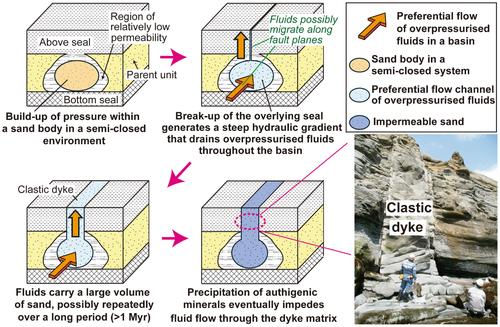当前位置:
X-MOL 学术
›
Basin Res.
›
论文详情
Our official English website, www.x-mol.net, welcomes your
feedback! (Note: you will need to create a separate account there.)
Geological conditions and fluid flow history that lead to the development of large clastic dykes in basins: A case study from Kushiro, Japan
Basin Research ( IF 2.8 ) Pub Date : 2024-10-21 , DOI: 10.1111/bre.70002 Shuji Tamamura, Takuma Murakami, Katsuhiko Kaneko, Tetsuro Yoneda, Tsutomu Sato, Jun Aizawa, Hiroyuki Matsumoto, Kagemi Uchida, Yoshiaki Suzuki, Toshifumi Igarashi
Basin Research ( IF 2.8 ) Pub Date : 2024-10-21 , DOI: 10.1111/bre.70002 Shuji Tamamura, Takuma Murakami, Katsuhiko Kaneko, Tetsuro Yoneda, Tsutomu Sato, Jun Aizawa, Hiroyuki Matsumoto, Kagemi Uchida, Yoshiaki Suzuki, Toshifumi Igarashi

|
Large clastic dykes (the Harutori‐Taro and Harutori‐Jiro dykes) and smaller dykes are exposed in the underground Kushiro Coal Mine (KCM), Japan. This study examines these dykes as a case study to investigate the geological conditions and fluid flow history that lead to the development of large clastic dykes in basins. The composition of the dykes indicates the Beppo and/or Harutori formations as their parent unit. Crystallite size distribution (CSD) analysis reveals Ostwald ripening of the kaolinite in the kaolinitised feldspar from the dykes, suggesting stagnant conditions in the parent unit before the dyke was formed. In contrast, smectite CSDs and the high carbonate content of the dykes suggest that large volumes of fluid flowed through the dykes along the established hydraulic gradient, which was triggered by the breaking of the upper seal. The isotopic and chemical compositions of the calcite and aragonite in the dykes, with moderate siderite and rhodochrosite content, indicate the fluid was a warm (>30°C) mixture of freshwater and saltwater, which was transferred from deeper levels of the parent unit towards the crest of an anticline. Immediately after sand injection, the semi‐closed system of the parent unit near the root of the large dyke was transformed into a major flow channel for overpressurised fluids. Subsequently, a large volume of fluid flowed along the vertical conduit (or dyke) over a long period of time (>1 Myr), which removed fluid from a widespread area (i.e., several hundred square kilometres) of the basin. The results show that thin parent units, poor lateral continuity of the upper seal, and spatially heterogeneous overpressurisation do not preclude the formation of large dykes.
中文翻译:

导致盆地中大型碎屑岩脉发育的地质条件和流体流动历史——以日本钏路为例
大型碎屑岩脉(Harutori-Taro 和 Harutori-Jiro 堤坝)和较小的岩脉暴露在日本钏路煤矿 (KCM) 的地下。本研究将这些岩脉作为案例研究进行研究,以调查导致盆地中大型碎屑岩脉发展的地质条件和流体流动历史。岩脉的组成表明 Beppo 和/或 Harutori 地层是它们的母体。微晶尺寸分布 (CSD) 分析显示,岩脉中高岭石化长石中的高岭石在 Ostwald 成熟,表明在岩脉形成之前,母体单元处于停滞状态。相比之下,蒙脱石 CSD 和堤坝的高碳酸盐含量表明,大量流体沿着既定的水力梯度流过堤坝,这是由上部密封破裂触发的。岩脉中方解石和文石的同位素和化学成分,以及适度的菱铁矿和菱锰矿含量,表明液体是淡水和盐水的温暖混合物(>30°C),从母体单元的更深层转移到背斜的顶部。注砂后,靠近大堤坝根部的母单元的半封闭系统立即转变为过压流体的主要流道。随后,大量流体在很长一段时间内沿着垂直管道(或堤坝)流动 (>1 Myr),从而从盆地的广泛区域(即几百平方公里)中带走了流体。结果表明,较薄的母单元、上密封的横向连续性差以及空间异质性过压并不排除大堤坝的形成。
更新日期:2024-10-21
中文翻译:

导致盆地中大型碎屑岩脉发育的地质条件和流体流动历史——以日本钏路为例
大型碎屑岩脉(Harutori-Taro 和 Harutori-Jiro 堤坝)和较小的岩脉暴露在日本钏路煤矿 (KCM) 的地下。本研究将这些岩脉作为案例研究进行研究,以调查导致盆地中大型碎屑岩脉发展的地质条件和流体流动历史。岩脉的组成表明 Beppo 和/或 Harutori 地层是它们的母体。微晶尺寸分布 (CSD) 分析显示,岩脉中高岭石化长石中的高岭石在 Ostwald 成熟,表明在岩脉形成之前,母体单元处于停滞状态。相比之下,蒙脱石 CSD 和堤坝的高碳酸盐含量表明,大量流体沿着既定的水力梯度流过堤坝,这是由上部密封破裂触发的。岩脉中方解石和文石的同位素和化学成分,以及适度的菱铁矿和菱锰矿含量,表明液体是淡水和盐水的温暖混合物(>30°C),从母体单元的更深层转移到背斜的顶部。注砂后,靠近大堤坝根部的母单元的半封闭系统立即转变为过压流体的主要流道。随后,大量流体在很长一段时间内沿着垂直管道(或堤坝)流动 (>1 Myr),从而从盆地的广泛区域(即几百平方公里)中带走了流体。结果表明,较薄的母单元、上密封的横向连续性差以及空间异质性过压并不排除大堤坝的形成。

































 京公网安备 11010802027423号
京公网安备 11010802027423号